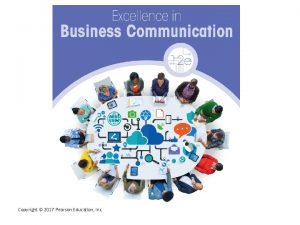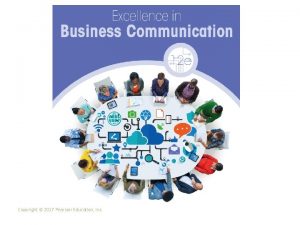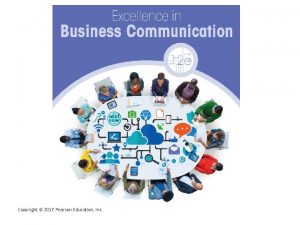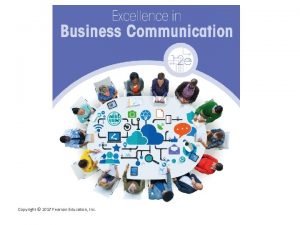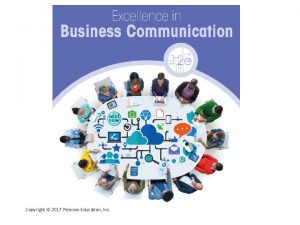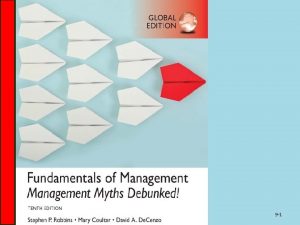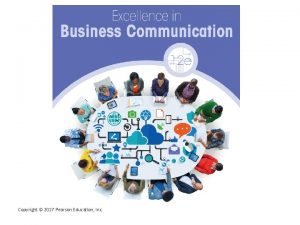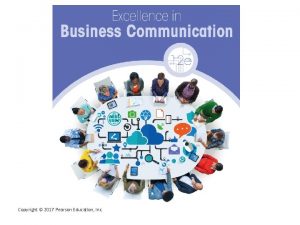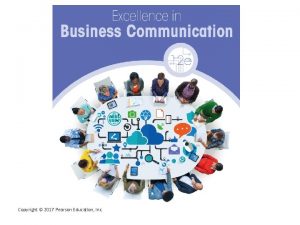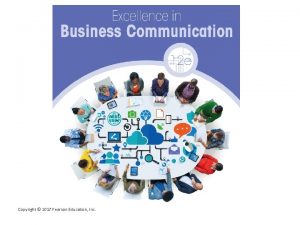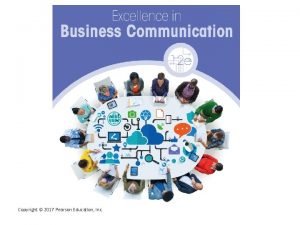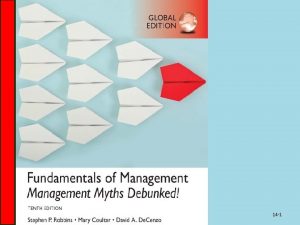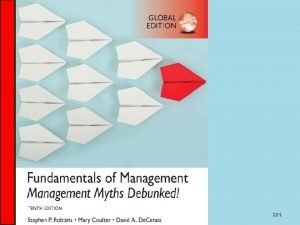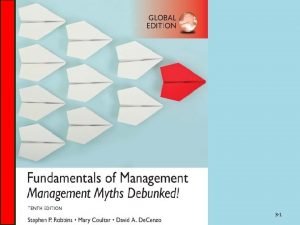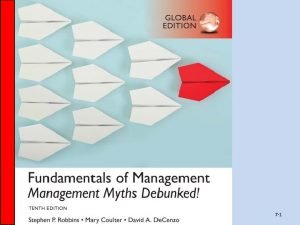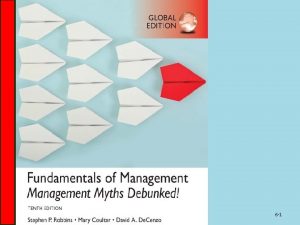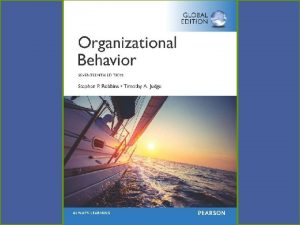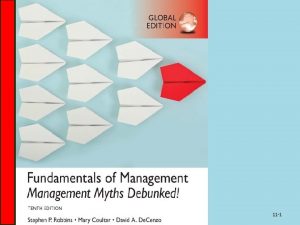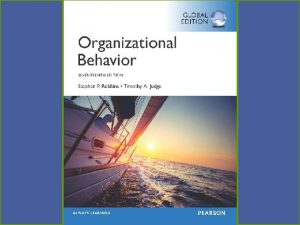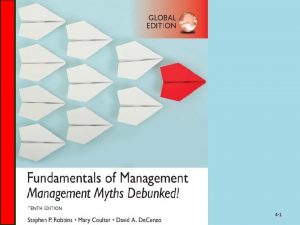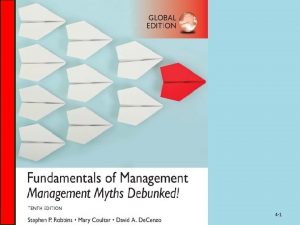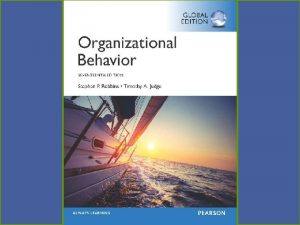Copyright 2017 Pearson Education Ltd 1 1 7






































- Slides: 38

Copyright © 2017 Pearson Education, Ltd. 1 -1

7 Motivation Concepts Copyright © 2017 Pearson Education, Ltd.

Learning Objectives q Describe three key elements of motivation. q Compare the early theories of motivation. q Contrast the elements of self-determination theory and goal-setting theory. q Demonstrate the differences among self-efficacy theory, reinforcement theory, equity theory, and expectancy theory. q Identify the implications of employee job engagement for managers. q Describe how the contemporary theories of motivation complement one another. Copyright © 2017 Pearson Education, Ltd. 7 -3

LO 1 Describe the Three Key Elements of Motivation ØMotivation is the processes that account for an individual’s intensity, direction, and persistence of effort toward attaining a goal. ØThe level of motivation varies both between individuals and within individuals at different times. Copyright © 2017 Pearson Education, Ltd. 7 -4

LO 1 Describe the Three Key Elements of Motivation ØThe three key elements of motivation are: 1. Intensity: concerned with how hard a person tries. 2. Direction: the orientation that benefits the organization. 3. Persistence: a measure of how long a person can maintain his/her effort. Copyright © 2017 Pearson Education, Ltd. 7 -5

LO 2 Compare the Early Theories of Motivation Copyright © 2017 Pearson Education, Ltd. 7 -6

LO 2 Compare the Early Theories of Motivation ØMaslow’s need theory has received wide recognition, particularly among practicing managers. Ø It is intuitively logical and easy to understand some research has validated it. Ø However, most research does, especially when theory is applied to diverse cultures. Copyright © 2017 Pearson Education, Ltd. 7 -7

LO 1 Compare the Early Theories of Motivation Copyright © 2017 Pearson Education, Ltd. 7 -8

LO 2 Compare the Early Theories of Motivation Copyright © 2017 Pearson Education, Ltd. 7 -9

LO 2 Compare the Early Theories of Motivation ØCriticisms of Herzberg’s theory: Ø Limited because it relies on self-reports. Ø Reliability of methodology is questioned. Ø No overall measure of satisfaction was utilized. Copyright © 2017 Pearson Education, Ltd. 7 -10

LO 2 Compare the Early Theories of Motivation Ø Mc. Clelland’s Theory of Needs Ø The theory focuses on three needs: Ø Need for achievement (n. Ach): drive to excel, to achieve in relation to a set of standards, to strive to succeed. Ø Need for power (n. Pow): need to make others behave in a way that they would not have behaved otherwise. Ø Need for affiliation (n. Afl): desire for friendly and close interpersonal relationships. Copyright © 2017 Pearson Education, Ltd. 7 -11

LO 2 Compare the Early Theories of Motivation ØMc. Clelland’s theory has had the best support. Ø It has less practical effect than the others. Ø Because Mc. Clelland argued that the three needs are subconscious—we may rank high on them but not know it—measuring them is not easy. Ø It is more common to find situations in which managers aware of these motivational drivers label employees based on observations made over time. Copyright © 2017 Pearson Education, Ltd. 7 -12

LO 3 Self-Determination Theory vs. Goal-Setting Theory ØSelf-Determination Theory Ø People prefer to feel they have control over their actions. ØPeople paid for work feel less like they want to do it and more like they have to it. Ø Proposes that in addition to being driven by a need for autonomy, people seek ways to achieve competence and positive connections to others. Copyright © 2017 Pearson Education, Ltd. 7 -13

LO 3 Self-Determination Theory vs. Goal-Setting Theory ØWhen extrinsic rewards are used as payoffs for performance, employees feel they are doing a good job. Ø Eliminating extrinsic rewards can also shift an individual’s perception of why he or she works on a task from an external to an internal explanation. ØSelf-determination theory acknowledges that extrinsic rewards can improve even intrinsic motivation under specific circumstances. Copyright © 2017 Pearson Education, Ltd. 7 -14

LO 3 Self-Determination Theory vs. Goal-Setting Theory ØWhat does self-determination theory suggest for providing rewards? ØSelf-concordance: considers how strongly people’s reasons for pursuing goals are consistent with their interests and core values. Copyright © 2017 Pearson Education, Ltd. 7 -15

LO 3 Self-Determination Theory vs. Goal-Setting Theory ØWhat does all of this mean? Ø For individuals: ØChoose your job for reasons other than extrinsic rewards. Ø For organizations: ØProvide intrinsic as well as extrinsic incentives. Copyright © 2017 Pearson Education, Ltd. 7 -16

LO 3 Self-Determination Theory vs. Goal-Setting Theory Ø Goals tell an employee what needs to be done and how much effort is needed. ØEvidence suggests: Ø Specific goals increase performance. Ø Difficult goals, when accepted, result in higher performance than do easy goals. Ø Feedback leads to higher performance than does non-feedback. Copyright © 2017 Pearson Education, Ltd. 7 -17

LO 3 Self-Determination Theory vs. Goal-Setting Theory Ø Three other factors influencing the goalsperformance relationship: Ø Goal commitment Ø Task characteristics Ø National culture Copyright © 2017 Pearson Education, Ltd. 7 -18

LO 3 Self-Determination Theory vs. Goal-Setting Theory ØPeople differ in the way they regulate their thoughts and behaviors. Ø Those with a promotion focus strive for advancement and accomplishment and approach conditions that move them closer toward desired goals. Ø Those with a prevention focus strive to fulfill duties and obligations and avoid conditions that pull them away from desired goals. Copyright © 2017 Pearson Education, Ltd. 7 -19

LO 3 Self-Determination Theory vs. Goal-Setting Theory Copyright © 2017 Pearson Education, Ltd. 7 -20

LO 3 Self-Determination Theory vs. Goal-Setting Theory ØGoal Setting and Ethics Ø The relationship between goal setting and ethics is quite complex: if we emphasize the attainment of goals, what is the cost? Ø We may forgo mastering tasks and adopt avoidance techniques so we don’t look bad, both of which can incline us toward unethical choices. Copyright © 2017 Pearson Education, Ltd. 7 -21

LO 4 Self-Efficacy, Reinforcement, Equity, and Expectancy Theory ØSelf-efficacy theory is an individual’s belief that he or she is capable of performing a task. Ø Enactive mastery Ø Vicarious modeling Ø Verbal persuasion Ø Arousal Ø Also known as social cognitive theory and social learning theory. Copyright © 2017 Pearson Education, Ltd. 7 -22

LO 4 Self-Efficacy, Reinforcement, Equity, and Expectancy Theory Copyright © 2017 Pearson Education, Ltd. 7 -23

LO 4 Self-Efficacy, Reinforcement, Equity, and Expectancy Theory ØImplications of self-efficacy theory: Ø The best way for a manager to use verbal persuasion is through the Pygmalion effect. ØA form of self-fulfilling prophecy – believing in something can make it true. Ø Training programs often make use of enactive mastery by having people practice and build their skills. Copyright © 2017 Pearson Education, Ltd. 7 -24

LO 4 Self-Efficacy, Reinforcement, Equity, and Expectancy Theory Ø Reinforcement theory: behavior is a function of its consequences. Ø Reinforcement conditions behavior. Ø Behavior is environmentally caused. ØGoal setting is a cognitive approach: an individual’s purposes direct his or her action. ØOperant conditioning theory: people learn to behave to get something they want or to avoid something they don’t want. Ø B. F. Skinner’s behaviorism. Copyright © 2017 Pearson Education, Ltd. 7 -25

LO 4 Self-Efficacy, Reinforcement, Equity, and Expectancy Theory ØSocial-learning theory: we can learn through both observation and direct experience. Ø Models are central, and four processes determine their influence on an individual: ØAttentional processes ØRetention processes ØMotor reproduction processes ØReinforcement processes Copyright © 2017 Pearson Education, Ltd. 7 -26

LO 4 Self-Efficacy, Reinforcement, Equity, and Expectancy Theory Copyright © 2017 Pearson Education, Ltd. 7 -27

LO 4 Self-Efficacy, Reinforcement, Equity, and Expectancy Theory ØWhen employees perceive an inequity, they can be predicted to make one of six choices: Ø Change their inputs. Ø Change their outcomes. Ø Distort perceptions of self. Ø Distort perceptions of others. Ø Choose a different referent. Ø Leave the field. Copyright © 2017 Pearson Education, Ltd. 7 -28

LO 4 Self-Efficacy, Reinforcement, Equity, and Expectancy Theory Copyright © 2017 Pearson Education, Ltd. 7 -29

LO 4 Self-Efficacy, Reinforcement, Equity, and Expectancy Theory ØExpectancy theory: a tendency to act in a certain way depends on an expectation that the act will be followed by a given outcome and on the attractiveness of that outcome to the individual. ØThree relationships: Ø Effort-performance relationship Ø Performance-reward relationship Ø Rewards-personal goals relationship Copyright © 2017 Pearson Education, Ltd. 7 -30

LO 4 Self-Efficacy, Reinforcement, Equity, and Expectancy Theory Copyright © 2017 Pearson Education, Ltd. 7 -31

LO 4 Self-Efficacy, Reinforcement, Equity, and Expectancy Theory ØExpectancy theory helps explain why a lot of workers aren’t motivated and do only the minimum. ØThree questions employees need to answer in the affirmative if their motivation is to be maximized: Ø If I give maximum effort, will it be recognized in my performance appraisal? Ø If I get a good performance appraisal, will it lead to organizational rewards? Ø If I’m rewarded, are the rewards attractive to me? Copyright © 2017 Pearson Education, Ltd. 7 -32

LO 5 Implications of Job Engagement for Management ØJob engagement: the investment of an employee’s physical, cognitive, and emotional energies into job performance. Ø Gallup organization: more engaged employees in successful organizations than in average organizations. Ø Academic studies: job engagement is positively associated with performance and citizenship behaviors. Copyright © 2017 Pearson Education, Ltd. 7 -33

LO 5 Implications of Job Engagement for Management ØWhat makes people more engaged in their job? Ø The degree to which an employee believes it is meaningful to engage in work. Ø A match between the individual’s values and the organization’s. Ø Leadership behaviors that inspire workers to a greater sense of mission. Copyright © 2017 Pearson Education, Ltd. 7 -34

LO 5 Implications of Job Engagement for Management ØAre highly engaged employees getting “too much of a good thing? ” Ø Construct is partially redundant with job attitudes. Ø It may have a “dark side. ” ØPositive relationships between engagement and work-family conflict. Copyright © 2017 Pearson Education, Ltd. 7 -35

LO 6 Compare Contemporary Theories of Motivation Copyright © 2017 Pearson Education, Ltd. 7 -36

Implications for Managers ØMake sure extrinsic rewards for employees are not viewed as coercive, but instead provide information about competence and relatedness. ØConsider goal-setting theory, as clear and difficult goals often lead to higher levels of employee productivity. Copyright © 2017 Pearson Education, Ltd. 7 -37

Implications for Managers ØConsider reinforcement theory regarding quality and quantity of work, persistence of effort, absenteeism, tardiness, and accident rates. ØConsult equity theory to help understand productivity, satisfaction, absence, and turnover variables. ØExpectancy theory also offers a powerful explanation of performance variables such as employee productivity, absenteeism, and turnover. Copyright © 2017 Pearson Education, Ltd. 7 -38
 Pearson education ltd
Pearson education ltd 2017 pearson education inc
2017 pearson education inc Pearson education ltd 2017
Pearson education ltd 2017 2017 pearson education inc
2017 pearson education inc 2010 pearson education inc
2010 pearson education inc 2009 pearson education inc
2009 pearson education inc 2018 pearson education inc
2018 pearson education inc Copyright 2014 pearson education inc
Copyright 2014 pearson education inc Copyright 2010 pearson education inc
Copyright 2010 pearson education inc Copyright 2010 pearson education inc
Copyright 2010 pearson education inc Copyright by pearson education inc. answers
Copyright by pearson education inc. answers 2008 pearson education inc
2008 pearson education inc Copyright 2009 pearson education inc
Copyright 2009 pearson education inc Copyright pearson education inc
Copyright pearson education inc Copyright 2010 pearson education inc
Copyright 2010 pearson education inc Copyright 2010 pearson education inc
Copyright 2010 pearson education inc Copyright 2010 pearson education inc
Copyright 2010 pearson education inc 2010 pearson education inc
2010 pearson education inc Copyright 2010 pearson education inc
Copyright 2010 pearson education inc Copyright 2010 pearson education inc
Copyright 2010 pearson education inc Pearson education inc all rights reserved
Pearson education inc all rights reserved Copyright 2009 pearson education inc
Copyright 2009 pearson education inc Copyright 2009 pearson education inc
Copyright 2009 pearson education inc Copyright 2009 pearson education inc
Copyright 2009 pearson education inc Copyright 2009 pearson education inc
Copyright 2009 pearson education inc Copyright pearson education inc
Copyright pearson education inc 2017 pearson education inc
2017 pearson education inc 2017 pearson education inc
2017 pearson education inc 2017 pearson education inc
2017 pearson education inc 2017 pearson education inc
2017 pearson education inc 2017 pearson education inc
2017 pearson education inc Pearson education 2017
Pearson education 2017 2017 pearson education inc
2017 pearson education inc Pearson education 2017
Pearson education 2017 2017 pearson education inc
2017 pearson education inc Nine compositional modes in digital media
Nine compositional modes in digital media 2017 pearson education inc
2017 pearson education inc 2017 pearson education inc
2017 pearson education inc 2017 pearson education inc
2017 pearson education inc


























